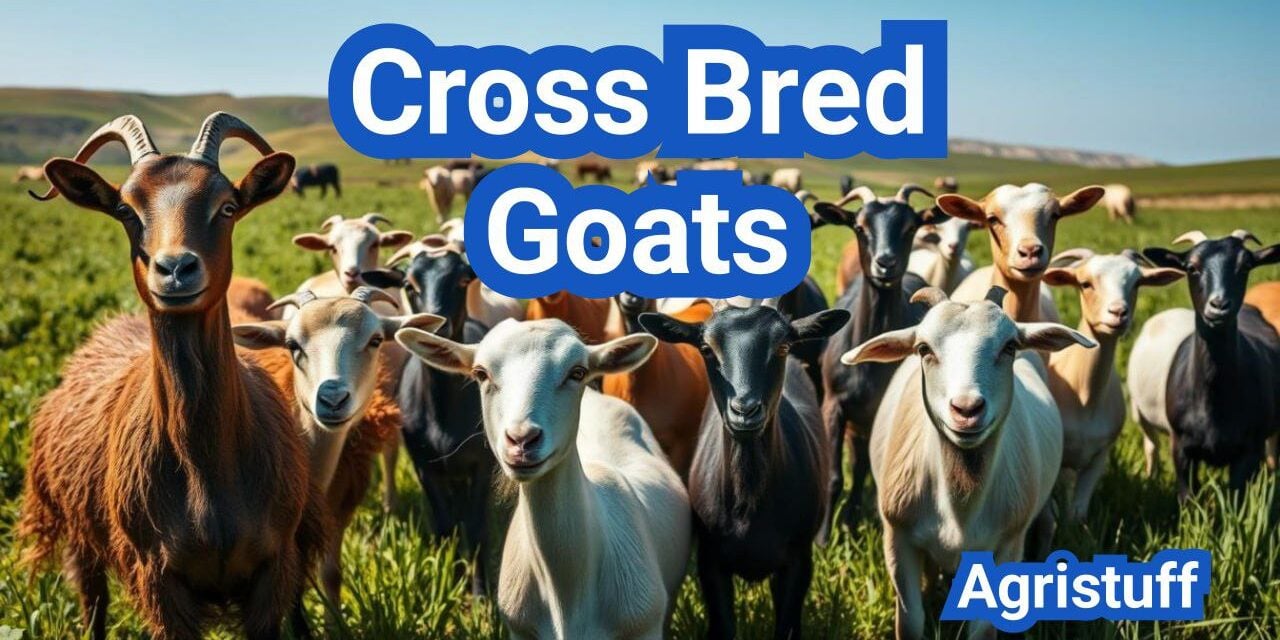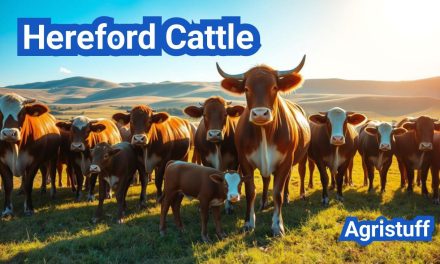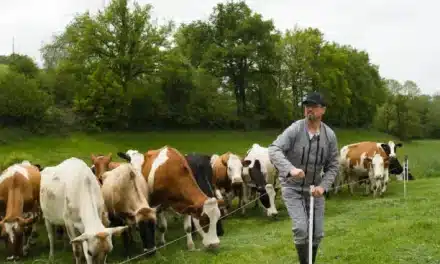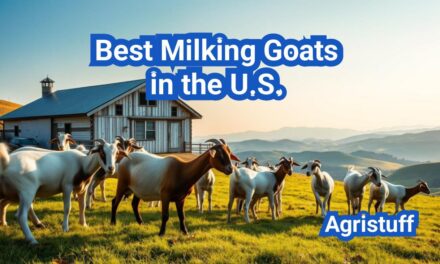Goat farming has become a significant contributor to the agricultural economy, with crossbreeding emerging as a key strategy to enhance efficiency and profitability. By combining the genetic strengths of different breeds, farmers can produce cross bred goats that excel in various aspects, such as meat and dairy production.
The practice of goat crossbreeding leverages hybrid vigor, resulting in offspring that are often more robust and productive than their purebred parents. This comprehensive guide will explore the benefits and challenges of crossbreeding, popular breeds, and best practices for goat farming, providing valuable insights for farmers and enthusiasts alike.
Key Takeaways
- Crossbreeding enhances the efficiency and profitability of goat farming.
- Hybrid vigor in goats results in more robust and productive offspring.
- Popular breeds and best practices are crucial for successful goat crossbreeding.
- Cross bred goats can excel in both meat and dairy production.
- A comprehensive understanding of goat crossbreeding is essential for farmers and enthusiasts.
Understanding Cross Bred Goats
Understanding crossbred goats requires a comprehensive look at their definition, characteristics, and the history behind their development. Crossbreeding introduces genetic diversity, leading to improved traits and overall performance.
What Are Cross Bred Goats?
Crossbred goats are the offspring of two different breeds or lines of goats. This breeding practice aims to combine the desirable traits of different breeds, such as improved growth rate, enhanced milk production, or increased disease resistance. By crossing breeds, farmers and breeders can create goats that are better suited to their specific needs and environments.
The resulting crossbred goats often exhibit hybrid vigor, also known as heterosis, which means they can outperform their purebred parents in certain traits. This phenomenon occurs because the genetic diversity introduced by crossbreeding can lead to improved overall health and productivity.
Difference Between Purebred and Crossbred Goats
Purebred goats belong to a specific breed and have a uniform genetic makeup, which can be beneficial for certain breeding programs. However, they may also be more susceptible to specific health issues or environmental challenges due to their limited genetic diversity.
Crossbred goats, on the other hand, benefit from the genetic diversity introduced by combining different breeds. This diversity can lead to improved adaptability, enhanced production traits, and increased resistance to diseases. The key difference lies in the genetic diversity and the potential for hybrid vigor in crossbred goats.
History of Goat Crossbreeding in the United States
The history of goat crossbreeding in the United States is closely tied to the development of the country’s agricultural practices and the demand for goat products. Initially, goat breeding focused on purebred animals, but as the industry evolved, crossbreeding became more prevalent.
The introduction of exotic breeds and the need for goats that could thrive in various environments drove the adoption of crossbreeding programs. Today, crossbred goats play a significant role in both small-scale and commercial goat operations across the United States.
The Science Behind Crossbreeding

The effectiveness of crossbreeding programs hinges on a deep understanding of the underlying genetic principles. Crossbreeding is a sophisticated technique that leverages the genetic makeup of parent breeds to produce offspring with desirable traits.
Genetics and Inheritance Patterns
Genetics plays a crucial role in determining the characteristics of crossbred goats. The study of genetics and inheritance patterns helps breeders predict the traits that will be passed on to the offspring. By understanding how genes interact, breeders can make informed decisions about which breeds to cross to achieve specific outcomes.
The inheritance patterns of certain traits, such as coat color or horn presence, follow Mendelian laws. However, traits like growth rate or milk production are influenced by multiple genes, making their inheritance patterns more complex.
Heterosis or Hybrid Vigor Explained
Heterosis, or hybrid vigor, refers to the phenomenon where crossbred offspring exhibit superior traits compared to their purebred parents. This can include accelerated growth rates, improved health, and enhanced productivity. Heterosis occurs because crossbreeding increases genetic diversity, reducing the chances of inheriting detrimental recessive genes.
- Increased growth rates
- Improved disease resistance
- Enhanced overall health
Genetic Diversity and Its Importance
Genetic diversity is vital for the long-term sustainability of crossbreeding programs. A diverse gene pool allows breeders to adapt to changing environmental conditions and market demands. It also reduces the risk of genetic disorders that can arise from inbreeding.
By maintaining a genetically diverse population, breeders can ensure that their crossbreeding programs remain resilient and productive over time.
Benefits of Crossbreeding Goats
The advantages of crossbreeding goats are multifaceted, ranging from improved productivity to enhanced disease resistance. By leveraging the genetic diversity of different breeds, farmers can create herds that are more resilient, productive, and adaptable to various environments.
Enhanced Production Traits
Crossbreeding allows farmers to combine the strengths of different breeds, resulting in increased milk production and better meat quality. For instance, crossing a high-milking breed like the Saanen with a hardy breed like the Kiko can result in offspring that produce more milk while being more resistant to environmental stresses.
Key Production Traits Improved by Crossbreeding:
- Increased milk yield
- Enhanced meat quality
- Faster growth rates
- Improved fertility rates
Improved Disease Resistance
One of the significant benefits of crossbreeding goats is the improvement in disease resistance. By introducing genes from breeds known for their hardiness, farmers can reduce the susceptibility of their herds to diseases. For example, crossing breeds with inherent resistance to certain parasites can lead to offspring that require fewer veterinary interventions.
Adaptability to Different Environments
Crossbred goats often exhibit greater adaptability to different environmental conditions. Breeds that are well-suited to hot climates can be crossed with those that thrive in cooler conditions, resulting in offspring that can perform well across a range of temperatures and humidity levels.
| Environmental Factor | Adaptability Trait | Benefit |
|---|---|---|
| High Temperatures | Heat Tolerance | Reduced heat stress |
| Low Temperatures | Cold Hardiness | Improved survival rates |
| High Humidity | Parasite Resistance | Reduced parasite load |
Economic Advantages
The economic benefits of crossbreeding goats are substantial. By improving production traits and disease resistance, farmers can reduce their operational costs and increase their revenue. For example, goats that produce more milk or grow faster can lead to higher returns per animal.
Economic Advantages Include:
- Reduced veterinary costs
- Increased revenue per animal
- Improved feed conversion efficiency
Popular Cross Bred Goats for Meat Production

Meat production is a significant aspect of the goat farming industry, with crossbreeding playing a crucial role in enhancing productivity. Crossbreeding programs have been developed to improve the genetic makeup of goats, resulting in better growth rates, improved meat quality, and increased disease resistance.
Boer Cross Combinations
Boer cross combinations are among the most popular for meat production due to their fast growth rates and improved meat quality. The Boer breed, known for its muscular build and rapid growth, is often crossed with other breeds to produce offspring with desirable traits.
- Improved Growth Rate: Boer crosses are known for their ability to gain weight quickly, making them ideal for meat production.
- Better Meat Quality: The crossbreeding of Boer goats with other breeds results in offspring with improved meat tenderness and flavor.
Kiko Crossbreeds
Kiko crossbreeds are another popular choice for meat production. Kiko goats are known for their hardiness and parasite resistance, making them an excellent choice for crossbreeding programs aimed at improving overall herd health.
- Kiko crosses are recognized for their enhanced disease resistance, reducing the need for veterinary interventions.
- They exhibit improved fertility rates, contributing to a more productive breeding program.
Spanish Goat Crosses
Spanish goat crosses have gained popularity due to their adaptability and robust nature. These crosses are often used in challenging environments where hardiness is a key factor.
- Adaptability: Spanish goat crosses are known for their ability to thrive in various environmental conditions.
- Hardiness: They possess a robust constitution, making them less susceptible to diseases.
Performance Metrics of Meat Crossbreeds
Evaluating the performance of crossbred goats is crucial for the success of any meat production program. Key performance metrics include growth rate, feed conversion efficiency, and disease resistance.
| Breed Cross | Growth Rate | Disease Resistance |
|---|---|---|
| Boer Cross | High | Moderate |
| Kiko Cross | Moderate | High |
| Spanish Goat Cross | Moderate | High |
Dairy Cross Bred Goats
Crossbreeding dairy goats with other breeds can lead to improved milk yields and disease resistance. This practice has gained popularity among dairy farmers looking to enhance their milk production while maintaining breed hardiness.
High-Yielding Dairy Crossbreeds
Dairy crossbred goats are known for their potential to produce high volumes of milk. Breeds like Saanen and Alpine are often crossbred with hardier breeds to create dual-purpose goats.
Nubian Cross Combinations are particularly valued for their rich milk and robust health. The Nubian breed, known for its high butterfat content, is often crossed with other dairy breeds to enhance milk quality.
Nubian Cross Combinations
Nubian crosses are favored for their milk’s rich flavor and high butterfat content. These crosses combine the Nubian’s excellent milk characteristics with the hardiness of other breeds.
Alpine and Saanen Crosses
Alpine and Saanen breeds are renowned for their high milk production. When crossed with other breeds, they produce offspring with excellent dairy traits and improved hardiness.
Alpine crosses are particularly noted for their consistent milk production, while Saanen crosses are valued for their high milk yield and gentle disposition.
Milk Production Comparisons
Comparing the milk production of different dairy crossbreeds can help farmers make informed decisions. The table below summarizes the average milk production of various dairy crossbreeds.
| Breed Combination | Average Milk Yield (liters/day) | Butterfat Content (%) |
|---|---|---|
| Nubian Cross | 3.5 | 4.5 |
| Alpine Cross | 4.0 | 3.8 |
| Saanen Cross | 4.2 | 3.5 |
As shown in the table, different dairy crossbreeds offer varying levels of milk production and butterfat content, allowing farmers to choose breeds that best suit their needs.
Dual-Purpose Cross Bred Goats

Dual-purpose crossbred goats are bred to excel in both milk yield and carcass quality, making them an attractive option for farmers looking to diversify their production.
Balancing Meat and Milk Production
Balancing meat and milk production in dual-purpose crossbred goats requires careful consideration of breeding goals and management practices. Farmers must decide whether to prioritize milk production, meat production, or achieve a balance between the two.
Key factors to consider:
- Genetic selection for desired traits
- Nutrition and feeding strategies
- Health management protocols
Popular Dual-Purpose Combinations
Several breed combinations are popular for dual-purpose production. These include crosses between dairy breeds like Alpine or Saanen with meat breeds like Boer.
| Breed Combination | Milk Production (lbs) | Meat Production (lbs) |
|---|---|---|
| Alpine x Boer | 1,500 | 80 |
| Saanen x Kiko | 1,800 | 90 |
| Nubian x Spanish | 1,200 | 70 |
Management Considerations
Effective management of dual-purpose crossbred goats involves a comprehensive approach to nutrition, health, and reproduction. Farmers must ensure that their goats receive adequate nutrition to support both milk and meat production.
Nutritional Requirements:
- High-quality forage
- Balanced concentrate feed
- Adequate water supply
By carefully managing these factors, farmers can optimize the productivity of their dual-purpose crossbred goats.
Designing a Crossbreeding Program
The success of a crossbreeding program hinges on several key factors, including clear breeding goals and the selection of appropriate parent breeds. A well-designed program can lead to significant improvements in productivity and profitability.
Setting Breeding Goals
Farmers should clearly define their breeding objectives, whether it’s to enhance milk production, improve meat quality, or increase disease resistance. Clear breeding goals help in selecting the right parent breeds and breeding systems.
Selecting Parent Breeds
The choice of parent breeds is critical and should be based on complementary traits that align with the breeding goals. For instance, if the goal is to improve milk production, breeds known for their high milk yield should be considered.
Breeding Systems: Two-Way, Three-Way, and Rotational
Different breeding systems offer various advantages. A two-way crossbreeding system involves two breeds and is relatively simple to manage. A three-way cross involves three breeds and can result in higher hybrid vigor. Rotational crossbreeding systems involve rotating between multiple breeds over generations.
| Breeding System | Advantages | Disadvantages |
|---|---|---|
| Two-Way Cross | Simple to manage, quick results | Limited genetic diversity |
| Three-Way Cross | Higher hybrid vigor, improved productivity | More complex to manage |
| Rotational Crossbreeding | Maintains genetic diversity, adaptable | Requires careful planning and record keeping |
Record Keeping and Performance Evaluation
Accurate record keeping is essential for evaluating the performance of the crossbreeding program. This includes tracking breeding dates, birth weights, growth rates, and milk production levels. Regular evaluation helps in making informed decisions and adjustments to the breeding program.
By carefully designing a crossbreeding program and maintaining detailed records, farmers can optimize their breeding outcomes and improve the overall efficiency of their operations.
Step-by-Step Guide to Cross Breeding Goats

A well-structured breeding program is crucial for the production of high-quality cross-bred goats. This guide will walk you through the essential steps to successfully cross-breed goats, from preparation to post-breeding care.
Preparing Your Breeding Stock
Before initiating the breeding process, it’s vital to select healthy, genetically superior breeding stock. This involves evaluating the goats’ health, genetic background, and production traits. A thorough examination ensures that the selected goats are free from genetic disorders and suitable for breeding.
The selection process should be based on clear criteria, including growth rate, fertility, and production potential. Record keeping is also crucial at this stage to track the lineage and characteristics of the breeding stock.
Timing and Heat Detection
Understanding the reproductive cycle of goats is critical for successful breeding. Does typically come into heat every 18-24 days, with the heat cycle lasting between 24 to 36 hours. Accurate heat detection is vital and can be achieved through observation of behavioral changes and physical signs.
Breeding Methods: Natural vs. Artificial Insemination
There are two primary breeding methods used in goat cross-breeding: natural mating and artificial insemination (AI). Natural mating involves introducing a buck to the does, while AI allows for the use of superior sires without the need for physical presence.
| Breeding Method | Advantages | Disadvantages |
|---|---|---|
| Natural Mating | Simple, low cost | Limited genetic diversity, disease risk |
| Artificial Insemination | Access to superior sires, increased genetic diversity | Requires expertise, higher cost |
Post-Breeding Care
After breeding, proper care and nutrition are essential to support the pregnancy and health of the doe. This includes providing a balanced diet, ensuring adequate nutrition, and maintaining a clean and safe environment.
Regular veterinary check-ups during pregnancy can help identify any potential issues early on, ensuring a healthy outcome for both the doe and the offspring.
Managing Cross Bred Goat Herds
Managing a crossbred goat herd requires a comprehensive approach that includes proper housing, nutrition, health management, and understanding flock dynamics. Effective herd management is crucial for maximizing productivity and ensuring the overall health and well-being of the goats.
Housing Requirements
Providing adequate housing is essential for protecting the goats from extreme weather conditions and predators. The housing should be well-ventilated, dry, and spacious enough to accommodate the herd comfortably.
- Ensure adequate ventilation to prevent respiratory issues.
- Provide enough space to reduce stress and prevent disease transmission.
- Use appropriate bedding materials like straw or sand to keep the area dry.
Nutrition and Feeding Programs
A well-balanced diet is critical for the health and productivity of crossbred goats. The nutritional needs vary depending on factors like age, breed, and production stage.
Nutritional Requirements:
| Nutrient | Requirement | Food Sources |
|---|---|---|
| Protein | 10-15% | Legume hay, grains |
| Energy | 2.5-3.0 Mcal/kg | Grains, corn |
| Calcium | 0.6-0.8% | Limestone, alfalfa hay |
| Phosphorus | 0.3-0.4% | Grains, bone meal |
Health Management Protocols
Implementing a robust health management program is vital for preventing diseases and maintaining the overall health of the herd. This includes regular vaccinations, parasite control, and monitoring for signs of illness.
- Develop a vaccination schedule in consultation with a veterinarian.
- Implement a parasite control program that includes deworming and monitoring.
- Regularly inspect the herd for signs of illness or stress.
Flock Dynamics and Behavior
Understanding the social dynamics within the herd is important for managing stress and preventing behavioral problems. Goats are social animals and establishing a hierarchy within the flock is natural.
Observing flock behavior can help in identifying issues early, such as bullying or health problems, allowing for timely intervention.
Challenges of Crossbreeding and How to Overcome Them
Crossbreeding goats can be a complex process, fraught with challenges that need to be addressed for success. While it offers numerous benefits, such as improved production traits and disease resistance, farmers must navigate several obstacles to achieve their breeding goals.
Genetic Unpredictability
One of the significant challenges in crossbreeding goats is genetic unpredictability. The offspring may not always inherit the desired traits from their parents, leading to variability in production and performance. To mitigate this, farmers can implement a robust selection program, carefully choosing breeding stock with desirable characteristics.
Selection criteria should include factors like growth rate, fertility, and disease resistance. By focusing on these traits, farmers can improve the predictability of their breeding outcomes.
“The key to successful crossbreeding lies in understanding the genetics behind the traits you are trying to improve.” – Dr. Jane Smith, Animal Breeding Expert
Breeding Program Sustainability
Maintaining a sustainable breeding program is crucial for long-term success. This involves ensuring genetic diversity within the herd, avoiding inbreeding, and regularly evaluating the performance of the breeding stock.
- Implementing a rotational breeding system can help maintain genetic diversity.
- Regular health checks and performance evaluations are essential for identifying areas for improvement.
- Keeping detailed records of breeding activities and outcomes is vital for making informed decisions.
Registration and Market Acceptance Issues
Registration and market acceptance can be significant challenges for crossbred goats. Many breed associations have strict registration criteria, which can limit the registration of crossbred animals.
To overcome these challenges, farmers can explore alternative registration options or work with breed associations to develop more inclusive registration policies. Additionally, educating buyers about the benefits of crossbred goats can improve market acceptance.
Market demand for crossbred goats is growing, driven by the need for more resilient and productive animals. By understanding and addressing the challenges associated with crossbreeding, farmers can capitalize on this trend and improve their breeding operations.
Unique Cross Bred Goat Combinations

Exploring the world of crossbred goats reveals a myriad of unique combinations that offer exciting opportunities for farmers and breeders. These combinations are the result of careful breeding programs designed to enhance desirable traits such as productivity, disease resistance, and adaptability.
Experimental Crosses
Experimental crosses in goat breeding involve combining different breeds to create new genotypes that can potentially outperform their parents. This approach allows breeders to innovate and tailor their breeding stock to specific production needs or environmental conditions. For instance, crossing a hardy local breed with a high-producing exotic breed can result in offspring that are both resilient and productive.
- Combining Boer goats with local breeds for improved meat production
- Crossing dairy breeds like Alpine or Saanen with indigenous goats to enhance milk yield
- Developing dual-purpose goats by crossing meat and dairy breeds
Cross Breed Goat and Sheep Hybrids
While less common, hybrids between goats and sheep (often referred to as “geep”) are another area of interest. These hybrids are usually the result of artificial insemination and are not always viable or fertile. However, successful hybrids can offer unique advantages, such as improved hardiness or specific production traits.
Rare and Specialty Crossbreeds
Rare and specialty crossbreeds represent the cutting edge of goat breeding innovation. These breeds are often developed for very specific purposes or to thrive in particular environments. Examples include crosses that are optimized for organic farming systems or for producing specialty dairy products.
- Identifying niche markets for specialty crossbreeds
- Developing breeding programs tailored to these niches
- Marketing the unique characteristics of these crossbreeds to potential buyers
In conclusion, unique crossbred goat combinations offer a wealth of opportunities for the goat breeding industry. By exploring experimental crosses, goat and sheep hybrids, and rare and specialty crossbreeds, farmers and breeders can develop more resilient, productive, and adaptable goat populations.
Economic and Market Considerations

Crossbred goats offer a promising solution for farmers looking to enhance their economic returns. By leveraging the benefits of crossbreeding, such as faster growth rates and higher yields, farmers can significantly improve their bottom line.
Cost-Benefit Analysis of Crossbreeding
A thorough cost-benefit analysis is essential to understand the economic viability of crossbreeding goats. This involves evaluating the costs associated with breeding, feeding, and maintaining crossbred goats against the potential benefits, such as increased meat or milk production.
Key factors to consider in a cost-benefit analysis include:
- Initial investment in breeding stock
- Feed costs and nutritional requirements
- Veterinary care and health management
- Potential revenue from selling crossbred goats or their products
Market Demand for Crossbred Products
Understanding market demand is crucial for the success of crossbred goat operations. Farmers need to identify whether there is a demand for meat, milk, or other products derived from crossbred goats in their target market.
Market research can help farmers:
- Identify target customers and their preferences
- Analyze competitors and market trends
- Determine the optimal pricing strategy for their products
Pricing Strategies for Crossbred Goats
Pricing strategies play a vital role in determining the profitability of crossbred goat operations. Farmers must consider factors such as production costs, market demand, and competition when setting prices for their goats or goat products.
A competitive pricing strategy can help farmers to stay ahead in the market. For instance, offering value-added products can justify higher prices due to the added value.
Value-Added Products from Crossbreeds
Creating value-added products from crossbred goats can significantly enhance economic returns. Examples include producing specialty cheeses, goat meat products, or value-added dairy products.
By diversifying their product offerings and targeting niche markets, farmers can increase their revenue streams and improve the overall profitability of their crossbred goat operations.
Case Studies: Successful Cross Bred Goat Operations in the USA

Successful crossbred goat farming in the United States is exemplified through numerous case studies, highlighting both small-scale and commercial operations. These examples demonstrate the potential and versatility of crossbreeding programs in enhancing productivity and profitability.
Small Farm Success Stories
Small farms across the USA have reported significant benefits from adopting crossbreeding programs. For instance, a farm in Tennessee achieved a 25% increase in milk production by crossing Saanen goats with Alpine bucks. Such improvements are not limited to dairy; meat production has also seen enhancements through strategic crossbreeding.
- A farm in Oregon increased its kid crop by 30% using Boer crossbreeds.
- In Texas, a small-scale operation improved its goat meat quality and market value by introducing Kiko genetics.
Commercial Scale Operations
On a larger scale, commercial goat operations have leveraged crossbreeding to achieve economies of scale and improve their market competitiveness. A notable example is a large dairy farm in California that implemented a rotational crossbreeding program among Nubian, Alpine, and Saanen breeds, resulting in a significant boost in milk yield and quality.
Commercial meat producers have also benefited, with operations in states like Oklahoma and Kansas reporting improved growth rates and carcass quality through the use of crossbred animals.
- A commercial farm in Oklahoma saw a 20% increase in average daily gain using crossbred Boer goats.
- In Kansas, a large-scale meat goat operation improved its dressing percentage by 15% through crossbreeding with Spanish goats.
Lessons Learned and Best Practices
These case studies highlight several key lessons and best practices for successful crossbred goat operations:
- Clear breeding objectives are crucial for the success of any crossbreeding program.
- Record keeping and performance evaluation are essential for making informed breeding decisions.
- Genetic diversity should be maintained to ensure the long-term sustainability of the breeding program.
By adopting these strategies, farmers across the USA have been able to enhance their operations, whether on a small or commercial scale, demonstrating the broad applicability and potential of crossbred goat farming.
Future Trends in Goat Crossbreeding
Goat crossbreeding is on the cusp of a revolution, driven by emerging breed combinations and sustainable practices. As the industry continues to evolve, farmers and breeders are looking towards the future to improve productivity, disease resistance, and environmental adaptability.
Emerging Breed Combinations
The development of new breed combinations is a significant trend in goat crossbreeding. By crossing different breeds, farmers can create animals that are better suited to their specific production systems and environments. For example, combining the hardiness of a local breed with the productivity of a specialized breed can result in offspring that excel in both areas.
Key emerging breed combinations include:
- Crossing Boer goats with local breeds to enhance meat production
- Combining Saanen and Alpine breeds for improved dairy production
- Developing dual-purpose breeds that balance meat and milk production
Technological Advancements in Breeding
Technological advancements are transforming the field of goat crossbreeding. Tools such as genetic testing and data analytics are allowing breeders to make more informed decisions about their breeding programs.
Some of the key technological advancements include:
- Genomic selection, which enables breeders to identify desirable genetic traits
- Artificial insemination, which allows for the widespread use of superior sires
- Data management systems, which help track performance and make data-driven decisions
“The integration of technology in goat breeding programs is not just a trend; it’s a necessity for those looking to stay competitive in a rapidly changing market.”
Sustainability and Climate Adaptation
Sustainability is becoming increasingly important in goat crossbreeding. Breeders are focusing on developing animals that are not only productive but also resilient to climate change. This involves selecting breeds that can thrive in challenging environmental conditions.
Strategies for sustainability include:
- Selecting breeds with inherent resistance to diseases and parasites
- Developing feeding programs that minimize environmental impact
- Implementing management practices that promote animal welfare
As the goat industry continues to evolve, the integration of emerging breed combinations, technological advancements, and sustainable practices will be crucial for its success. By embracing these trends, farmers and breeders can improve productivity while ensuring the long-term viability of their operations.
At The End of: Cross Bred Goats
Crossbreeding goats offers numerous benefits, including enhanced productivity and adaptability, making it a valuable practice for goat farmers in the United States. By understanding the science behind crossbreeding and implementing effective breeding programs, farmers can improve the overall quality and profitability of their goat herds.
The benefits of crossbreeding goats are multifaceted, ranging from improved disease resistance to increased milk and meat production. By leveraging these advantages, farmers can better meet the demands of the market and improve their bottom line. As the goat industry continues to evolve, the strategic use of crossbred goats is likely to play a significant role in shaping its future.
By applying the principles and best practices outlined in this guide, goat farmers can make informed decisions about crossbreeding and maximize the crossbreeding benefits. This approach will enable them to stay competitive and achieve their production goals.
FAQ
What are Cross Bred Goats?
Cross Bred Goats are the offspring of two different goat breeds, often used to combine the beneficial traits of both parents, such as improved milk production, meat quality, or disease resistance.
What are the benefits of crossbreeding goats?
Crossbreeding goats can result in enhanced production traits, improved disease resistance, and adaptability to different environments, ultimately leading to increased productivity and profitability.
Can I crossbreed different types of goats?
Yes, you can crossbreed different types of goats, but it’s essential to choose breeds that complement each other and have compatible characteristics.
What is heterosis or hybrid vigor in goats?
Heterosis, or hybrid vigor, refers to the phenomenon where crossbred goats exhibit superior traits compared to their purebred parents, resulting in improved productivity and performance.
How do I design a crossbreeding program for my goat farm?
To design a crossbreeding program, you need to set clear breeding goals, select suitable parent breeds, and choose a breeding system that suits your farm’s needs and resources.
What are the most popular Cross Bred Goats for meat production?
Popular Cross Bred Goats for meat production include Boer, Kiko, and Spanish goat crosses, known for their improved growth rates and meat quality.
How do I manage a Cross Bred Goat herd?
Managing a Cross Bred Goat herd requires attention to housing, nutrition, health management, and flock dynamics to ensure the overall health and productivity of the goats.
What are the challenges associated with crossbreeding goats?
Challenges associated with crossbreeding goats include genetic unpredictability, breeding program sustainability, and registration and market acceptance issues.
Can I register my Cross Bred Goats with a breed association?
Registration policies vary among breed associations, but some allow registration of crossbred goats, while others may have specific requirements or restrictions.
How do I determine the value of my Cross Bred Goats?
The value of Cross Bred Goats is determined by factors such as their production traits, genetics, and market demand, as well as the overall quality and health of the animals.
What are the future trends in goat crossbreeding?
Emerging trends in goat crossbreeding include the development of new breed combinations, technological advancements in breeding, and a focus on sustainability and climate adaptation.
Conclusion of: Cross Bred Goats
What Are Cross Bred Goats?
Cross Bred Goats are goats produced by mating two or more different breeds to combine their best traits into a single, more productive animal. Instead of relying only on one pure breed, farmers use Cross Bred Goats to capture “hybrid vigor,” where offspring often grow faster, stay healthier, or produce more milk and meat than their parents. In many systems, Cross Bred Goats are designed to blend the productivity of specialized meat or dairy breeds with the hardiness, fertility, and disease resistance of local or traditional goats, making Cross Bred Goats especially attractive for small and medium farms in the United States that face variable climate and forage conditions. Learn more from FAO livestock resources
Why Farmers Use Cross Bred Goats
Farmers choose Cross Bred Goats because they can better match real-world farm conditions than many purebreds alone. Cross Bred Goats are often more adaptable to heat, cold, and inconsistent pasture quality, while still delivering strong growth rates and kidding performance. By carefully planning crosses, producers can create Cross Bred Goats that reach market weight sooner, maintain body condition on pasture, and provide enough milk for fast-growing kids or small-scale home use. For commercial U.S. goat farms, Cross Bred Goats can help fill niche and ethnic meat markets throughout the year, improve productivity per acre, and make better use of available land and forage resources. See USDA NIFA programs on small ruminant production
Key Breeds Used to Create Cross Bred Goats
The most successful Cross Bred Goats usually come from combining proven meat and dairy breeds that complement each other. For meat-focused Cross Bred Goats in the USA, Boer, Kiko, and Spanish goats are commonly used to produce kids with good muscling, growth, and hardiness. For dairy-leaning Cross Bred Goats, producers often work with Alpine, Nubian, Saanen, LaMancha, or Toggenburg genetics to balance milk yield, butterfat, and temperament. By pairing hardy local does with specialized sires, farms can develop Cross Bred Goats that are well suited to their climate, pasture base, and marketing goals without losing the adaptability of native or long-established goat types. Explore goat breed guides at Oklahoma State University Extension
Genetic Principles Behind Cross Bred Goats
The performance advantages of Cross Bred Goats are rooted in genetics, especially the concepts of heterosis and complementarity. When unrelated breeds are crossed, many Cross Bred Goats show improved fertility, survival, and growth compared with purebreds, because harmful recessive genes are less likely to pair and beneficial gene combinations are more frequent. At the same time, breeders design Cross Bred Goats so that one breed contributes strengths, such as high milk yield, while another adds traits like parasite resistance or hoof soundness. Understanding these basic genetic principles helps farmers avoid random mixing and create consistent lines of Cross Bred Goats that perform predictably over time. Review scientific articles on goat crossbreeding at ScienceDirect
Cross Bred Goats for Meat Production
Many U.S. producers rely on Cross Bred Goats to supply the growing demand for chevon and kid meat in ethnic, specialty, and holiday markets. Meat-focused Cross Bred Goats, often based on Boer, Kiko, and Spanish lines, can reach market weights more quickly and with better carcass quality than unimproved local stock, especially when raised on well-managed pasture and browse. These Cross Bred Goats are typically selected for rapid growth, strong legs and feet, good muscling, and efficient feed conversion, allowing farmers to finish kids at weights preferred by local buyers and processors. As a result, Cross Bred Goats can significantly improve the economic returns of meat-goat enterprises when managed carefully. Find meat goat production resources at University of Minnesota Extension
Cross Bred Goats for Milk Production
While specialized dairy breeds remain the backbone of commercial dairies, Cross Bred Goats play an important role in small-scale and dual-purpose systems. By crossing high-yield dairy breeds such as Saanen or Alpine with hardy local animals, farmers can create Cross Bred Goats that produce respectable milk volumes while staying robust under variable feeding and housing conditions. These Cross Bred Goats can support household milk needs, small artisan cheese or soap ventures, and efficient kid growth for meat, offering flexibility that purebred dairy lines sometimes lack in harsh or resource-limited environments. With good nutrition and health care, dairy-type Cross Bred Goats can be a cornerstone of diversified homestead or niche dairy operations. Read dairy goat guidance at Penn State Extension
Adaptation and Disease Resistance in Cross Bred Goats
One of the strongest arguments for using Cross Bred Goats is their potential for improved adaptation and health. When hardy local goats are crossed with selected meat or dairy breeds, the resulting Cross Bred Goats can show better tolerance to heat, humidity, rough terrain, and limited feed. In addition, some breeds used in Cross Bred Goats are known for stronger resistance to internal parasites, hoof problems, and other common health challenges. Even so, Cross Bred Goats are not disease-proof; they simply offer a better starting point for resilience when combined with good management, pasture rotation, and regular health monitoring on U.S. farms. Consult USDA APHIS animal health information
Cross Bred Goats in the United States Market
In the United States, Cross Bred Goats now make up a large share of the national herd, particularly in meat-goat operations serving ethnic communities and specialty retailers. Surveys and market reports show that demand for goat meat has risen steadily, and Cross Bred Goats give producers the flexibility to supply different carcass sizes and quality grades. Many commercial herds use hardy crossbred does with terminal sires to produce kids that fit these markets, while some farms also maintain dairy-based Cross Bred Goats for local milk and cheese. As consumer interest in diverse proteins and sustainable grazing grows, Cross Bred Goats are likely to remain central to U.S. goat production systems. Review livestock market trends at USDA ERS
Planning a Breeding Program with Cross Bred Goats
Success with Cross Bred Goats starts with a clear breeding plan rather than random matings. Farmers should first define their goals, such as producing 60–80 lb meat kids, dual-purpose Cross Bred Goats for family milk and meat, or hardy brush-control herds. Once the objective is clear, appropriate breeds and sires can be chosen, and simple breeding systems like terminal crosses or two-breed rotations can be designed. Record keeping is essential for Cross Bred Goats, because tracking birth weights, growth rates, and kidding performance allows producers to identify the most productive lines and to cull animals that do not meet expectations over several seasons. Access goat breeding factsheets at Ohio State University Extension
Feeding and Nutrition of Cross Bred Goats
Although Cross Bred Goats may convert feed more efficiently than unimproved stock, they still require balanced nutrition to reach their full genetic potential. Productive Cross Bred Goats need good-quality pasture or browse, access to clean water, and, when necessary, supplements that provide energy, protein, minerals, and vitamins. Growing kids, pregnant does, and lactating does have different nutritional needs, so ration planning must be tailored to each stage. In the U.S., many farms rely on browse, mixed pastures, and strategic hay and grain supplementation to keep Cross Bred Goats gaining steadily, while also using mineral mixes and salt blocks formulated for goats to prevent deficiencies. Learn about pasture and grazing management from USDA NRCS
Health Care and Biosecurity for Cross Bred Goats
Good health management is crucial for Cross Bred Goats, even when they show better resilience than some purebreds. Internal parasites, respiratory diseases, hoof problems, and mineral imbalances can still limit the performance of Cross Bred Goats if not addressed in time. Producers should work with veterinarians to design vaccination schedules, fecal egg count–based deworming plans, and hoof care routines that suit their region. Because crossbreeding programs often involve buying new sires or replacement does, biosecurity measures such as quarantine, disease testing, and careful introduction to the herd are vital to protect Cross Bred Goats from contagious diseases that may enter from outside sources. Consult the Merck Veterinary Manual for goat health information
Economic Considerations of Cross Bred Goats
From an economic perspective, Cross Bred Goats can improve profitability when they produce more marketable meat or milk per unit of feed, land, and labor than unimproved animals. Many U.S. studies show that efficient Cross Bred Goats can help farmers access growing ethnic markets, stabilize cash flow from livestock sales, and make better use of brushy or marginal land. However, the economics of Cross Bred Goats depend on careful cost control, including feed budgets, fencing investments, and health expenditures. Producers should regularly analyze their enterprise budgets, compare performance across years, and adjust herd size and breeding strategies to keep Cross Bred Goats profitable under changing market and climate conditions. Explore economic research on meat goats at AgEcon Search
Cross Bred Goats for Small Farms and Homesteads
Small farms and homesteads often find that Cross Bred Goats offer more flexibility than maintaining multiple purebred lines. A thoughtfully designed herd of Cross Bred Goats can supply family milk, meat for the freezer, and natural brush control, all from the same group of animals. For new goat owners, crossbred does are usually easier to find and more affordable than registered purebreds, and they may be more forgiving of management mistakes. With patient handling and consistent routines, Cross Bred Goats can fit into mixed farming systems that also include crops, poultry, and other livestock, helping families diversify income and improve land use on a small scale. Visit USDA resources for small and beginning farmers
Challenges and Limitations of Cross Bred Goats
Despite many advantages, Cross Bred Goats are not a perfect solution for every farm. Without a breeding plan and good records, herds of Cross Bred Goats can quickly become inconsistent in size, growth, and temperament, making marketing more difficult. In some harsh environments, highly improved crossbreds may struggle to survive or reproduce as well as locally adapted indigenous goats. Cross Bred Goats may also require better nutrition and health care to reach their potential, which can raise costs. These limitations highlight the need to match Cross Bred Goats carefully to the farm’s climate, feed resources, management skills, and local market demand. Read global perspectives on goat systems at FAO
Practical Tips to Get Started with Cross Bred Goats
New producers interested in Cross Bred Goats should start small, learn from experienced neighbors, and use extension resources to avoid common mistakes. Visiting local goat farms, livestock auctions, and educational field days is a good way to see which crossbred types perform well in the area. When buying initial stock, it is wise to choose healthy, proven does and a sound buck from reputable breeders, then build a simple crossbreeding system that fits the farm’s goals. Over time, weighing kids, recording kidding dates, and tracking health events will help refine the line of Cross Bred Goats, making the herd more uniform, productive, and profitable. Use step-by-step goat management guides from Extension services
Future Trends in Cross Bred Goats
Looking ahead, Cross Bred Goats are likely to become even more important as climate variability, land pressures, and changing consumer preferences shape livestock production. Researchers are focusing on genetic tools to identify lines of Cross Bred Goats with superior parasite resistance, heat tolerance, and feed efficiency, helping producers maintain productivity with fewer chemical inputs. At the same time, niche markets for grass-fed, sustainably raised meat and artisanal dairy products are expanding, and Cross Bred Goats are well positioned to serve these emerging opportunities in the United States. By combining modern genetics with practical, farmer-led selection, the next generation of Cross Bred Goats will likely be even better adapted to diverse farm systems. Follow small ruminant research updates at USDA NIFA
Final Thought
Cross Bred Goats give farmers and homesteaders a powerful way to blend the strengths of different breeds into animals that truly fit their land, climate, and market. When you design a clear breeding plan, support Cross Bred Goats with good nutrition and health care, and track performance from year to year, the herd can evolve into an efficient, resilient asset for the whole farm. At the same time, Cross Bred Goats are not a shortcut; they still depend on thoughtful management and realistic expectations. With patience and planning, however, Cross Bred Goats can help U.S. producers build more sustainable, profitable, and flexible goat enterprises for the future. Discover sustainable livestock strategies at SARE
Sources & References
- United States Department of Agriculture (USDA)
- USDA Animal and Plant Health Inspection Service (APHIS)
- Ohio State University Extension – Ohioline Goat Factsheets
- AgEcon Search – Economic Studies on Goat Production
- ScienceDirect – Research Articles on Goat Breeding and Genetics
- USDA Economic Research Service – Livestock and Meat Markets
- USDA NRCS – Pasture and Grazing Management











